The new, expanded facility, completed in 2021, can generate up to 1.7 megawatts of clean, renewable electricity, displacing more than 1.3 million litres of imported diesel fuel.
Powering Klemtu: Kitasoo Xai’xais Upgrade Hydropower System
Estimated Reading time

15 Mins

Klemtu is located on the east side of Swindle Island in Finlayson Channel, approximately 219 kilometres north of Vancouver Island in the coastal fjords of British Columbia, Canada.
At a Glance
For more than forty years, the community of Klemtu, on Swindle Island off the central coast of British Columbia, has generated most of its electricity from a hydroelectric power facility owned and operated by Kitasoo Xai’xais Nation.
The original facility, which began operating in 1980, could generate up to 600 kilowatts of electricity and was nearing the end of its useful life. At the same time, with new businesses taking root and community members wanting to return to Klemtu, the community needed more electricity to meet its current and future needs.
The new, expanded facility, completed in 2021, can generate up to 1.7 megawatts of clean, renewable electricity, displacing more than 1.3 million litres of imported diesel fuel and reducing cumulative greenhouse gas emissions by about 145,996 tonnes of carbon dioxide equivalent over the project’s life.
With the new generating capacity, the community is upgrading homes with electric heat pumps, saving money and reducing the community’s overall reliance on fossil fuels.
An Island of Abundance

Kitasoo Xai’xais Nation is an amalgamation of two distinct tribes: the Kitasoo members of the Tsimshian Nation who originally lived in Kitasu Bay, and the Xai’xais, who originally lived in Kynoc Inlet. In the 1860s, these two communities came together in Klemtu, a village on the east side of Swindle Island, to take advantage of its strategic location on the inside passage.
Today, Klemtu is home to about 350 people, and, in Chief Councillor Doug Neasloss’ view, “is the most beautiful village in all of the Great Bear Rainforest.”
“Living here…you hear the rain, you hear the water, you hear the whales in the bay,” says Isaiah Robinson, an elected councillor and General Manager of the Kitasoo Development Corporation. “We’re very much blessed to have a front water view of what happens within our territory.”
“And we’re busy,” adds Chief Neasloss. “We’ve built a healthy economy here.”
It’s also a very diverse economy. Between aquaculture, seafood processing, stewardship, ecotourism, and research and guardian programs, Klemtu boasts one of the highest employment rates on the coast, with 95 per cent of adults working.
Living here…you hear the rain, you hear the water, you hear the whales in the bay. We’re very much blessed to have a front water view of what happens within our territory.

Energy Sovereignty
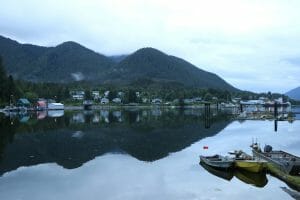
Klemtu, like many coastal communities, is “off grid” and must generate its own electricity.
“We used to have a diesel generator to power the community,” recalls Chief Neasloss. “To conserve diesel… they used to shut it off around 12:00 in the morning until the next day.” With the diesel-fired generators shut off overnight, residents would rely on wood and oil powered stoves for heat.
In the 1970s, the Kitasoo Xai’xais built a hydroelectric facility at Baron Lake, using water and gravity to generate 600 kilowatts of power. For decades, the facility created enough electricity to meet most of the community’s needs, powering the band office, homes, and businesses, and helping the Nation to progress towards energy sovereignty.
However, as the community and local economy grew, so too did the need for electricity. In the winter months, demand increased as families used electricity to heat their homes and prepare hot meals. When the aging hydro facility couldn’t keep up with the demand, or if the facility’s supply of water was disrupted, residents experienced outages.
“We were having brownouts every winter,” says Chief Neasloss. “A lot of people were using these little space heaters…and those are not energy efficient and do draw a lot of power. You could almost time it: lunchtime, you would get a power spike; dinnertime, you would get a power spike.”
When the hydro facility couldn’t generate enough electricity, the Nation would ask residents to reduce electricity use – limiting cooking and heating – and turn to diesel generators to make up the difference. Due to the unreliability of the community’s grid, Kitasoo Seafoods and Kitasoo Wild Seafoods, major employers, were also relying on diesel electricity to operate their seafood processing plants.
We were having brownouts every winter. You could almost time it: lunchtime, you would get a power spike; dinnertime, you would get a power spike.
Diesel fuel is a flexible, portable source of energy for coastal communities, though it comes with many drawbacks. The generators can be noisy, disturbing residents and wildlife. Transporting and storing fuel comes with the risk of costly spills and accidents. And, finally, burning diesel emits large amounts of greenhouse gases, as well as contaminants that can harm ecosystems and impact vulnerable community members, if the generators are close to homes.
“We did an environmental cleanup a few years ago,” says Chief Neasloss. “And we ended up spending more than $20 million…a lot of that was from fossil fuels: diesel hitting the ground, or gas, or metal contaminants.”

If the old hydro facility had failed, the community would have needed 1.3 million litres of diesel fuel to generate enough power. Over the 40-year life of a hydro facility, that amount of diesel would emit about 145,996 tonnes of carbon dioxide equivalent.
To put that number in context, 3,650 tonnes emitted per year is about the same as driving 794 average Canadian vehicles.
As part of its CleanBC plan, the Province of British Columbia aims to reduce diesel consumption for generating electricity by 80 per cent by 2030 and is working with remote communities to improve energy options and reduce emissions. For communities, switching to renewable energy can come with significant cost savings.
“One of the biggest reasons [we chose hydro] was the cost of diesel,” says Neasloss. “Trying to power the whole community on diesel [in the 1970s] was pretty expensive. And today, it’s still expensive.”
Weather and spill risks are an additional complication. Storms can delay the import of needed fuels and increase the likelihood of accidents.
The 2016 Nathan E. Stewart oil spill is an example that won’t soon be forgotten. Sixty kilometres south of Klemtu, an American-owned tug and barge ran aground near Wáglísla Bella Bella, in Haíɫzaqv territory. The vessel eventually sank, spilling 110,000 litres of diesel, heavy oils, and other pollutants into Q’vúqvai Gale Pass and damaging culturally important shellfish harvesting sites.
By transitioning to renewable energy sources and away from imported fuels, First Nations have more control over their energy systems and are empowered to make decisions on their energy needs, sources, and future plans.
Using Elevation, Water to Create Electricity
“The basic concept for any hydropower project is that you have water starting at one elevation, going through a turbine generator, and exiting at another elevation,” says Taylor Stubbins, a project coordinator with Barkley Project Group, which consulted on the project. “Fortunately, on the west coast, we have lots of water and lots of changes in elevation. That’s why hydro is so important here.”
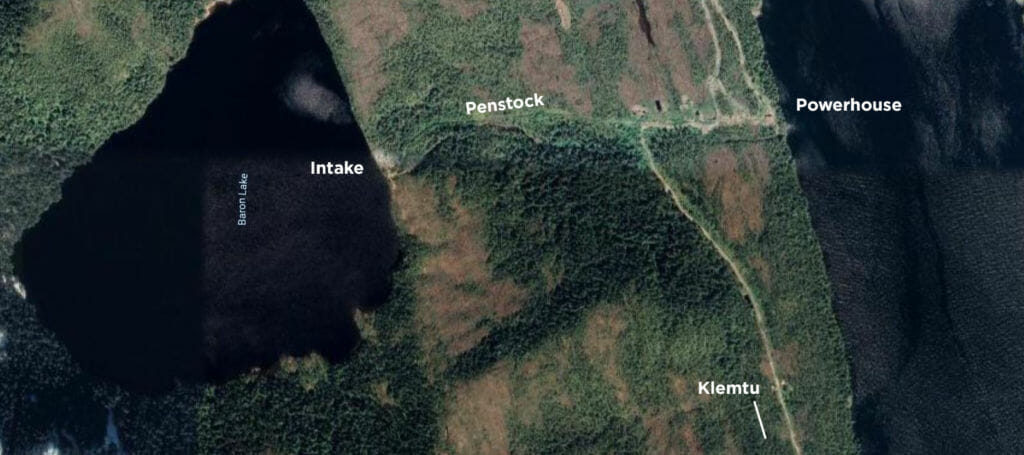
The Klemtu hydroelectric facility draws water from an intake on Baron Lake, which sits at the top of a mountain, at an elevation of 346 metres above sea level. Water from the lake flows in a stream down the side of the mountain and into the ocean.
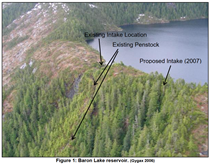
“It’s the perfect setup for a hydropower project,” says Stubbins. The Baron Lake facility takes advantage of the natural drop in elevation to generate electricity. A penstock, which is a high-pressure pipe, brings lake water down the mountain to a powerhouse, located at an elevation of 24 metres.
As the water drops down the one-kilometre-long penstock, it gains pressure. At the powerhouse, the water is released in jets that drive a Pelton wheel turbine connected to an electrical generator. In 2009, the Nation upgraded the powerhouse to support a generation capacity of up to 1.8 megawatts.
In addition to its age, the original hydro facility had two weaknesses: the diameter of the penstock limited the amount of water being carried to the powerhouse and the position of the intake on Baron Lake left the system vulnerable to seasonal fluctuations in water levels.
To upgrade, Kitasoo Xai’xais Nation built a larger penstock to increase the flow of water to the turbine, boosting the powerhouse’s generating capacity from 0.6 to 1.7 megawatts.
“Maxing out our system put so many limitations on our community. We couldn’t look at building new houses without first expanding our power,” says Chief Neasloss. “Now that we’ve done this upgrade – going from 600 kilowatts to a bit over 1,600 kilowatts – this will allow us to build more homes and move towards more energy efficient heating systems.”
The original intake on Baron Lake was positioned in the weir, only two metres below the full lake level. During the driest months, the water level would sometimes drop below the intake, halting electricity generation. In 2019, a severe drought prompted the Nation to shut down the hydro system for two months, necessitating a manual switch to diesel and costing the community tens of thousands of dollars in fuel.
To improve the long-term climate resiliency of this renewable energy facility, the Nation moved the intake lower, allowing for up to five metres of active storage in the water level and extending the facility’s generating range.
It’s the perfect setup for a hydropower project.
“In the past when the water would drop a meter or two, they wouldn’t be able to generate electricity anymore,” says Stubbins. “Now, the water can drop four to five meters and [the facility will] continue to generate electricity and that will help get [the community] through the summer months.”
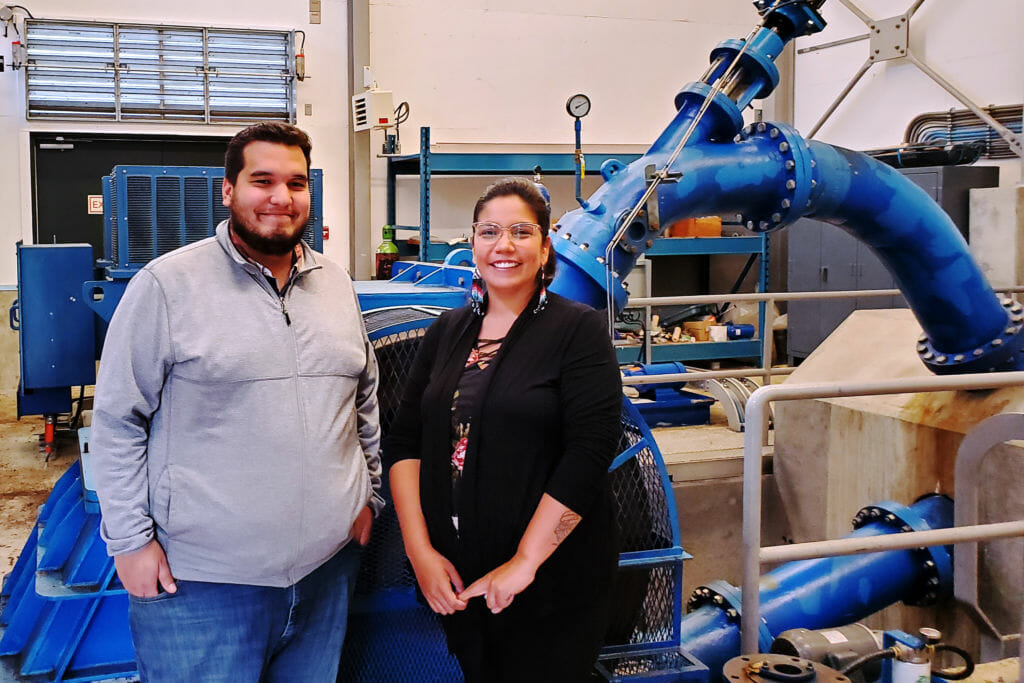
With the new intake, New Energy Design Ltd., the electrical consultant and contractor, estimates that the lake can actively store enough water near the surface to generate power for up to six months without rainfall.
“The lake at the top of mountain has no fish,” says Stubbins. “So, there’s really no major environmental concerns with the fluctuating water levels.”
If water levels drop significantly, the system can switch to a diesel backup. And, because the whole system can now be operated and monitored remotely, community members don’t need to travel the three kilometres from their homes to the powerhouse to manually switch between power sources.
Taken together, the upgrades have extended the life of the Nation’s hydroelectric facility, increased the system’s resilience, and reduced the need for diesel fuel. With maintenance, the upgraded system will provide clean, reliable electricity for another 40 years.
“I think the community is excited to have the new upgrade,” says Chief Neasloss. “I think they understand that this will allow us to move forward and continue to expand on housing and look at other clean technology.”

Construction During a Pandemic
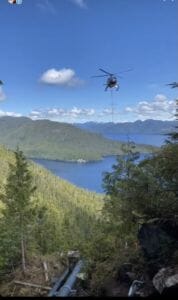
In 2014, the Kitasoo Xai’xais began working with renewable energy consultants to explore options for increasing Klemtu’s electrical capacity. The community considered solar and wind before deciding to upgrade its hydro facility.
“We’ve explored all options…as the technology gets better, we’ll continue to look at new options,” says Chief Neasloss. “To me, the most fitting [option] was hydropower, because we have a river and this is probably one of the wettest places in Canada.”
Once the community had committed to upgrading its hydroelectric facility, Kitasoo Xai’xais worked with consultants, including Barkley Group, to design the project and identify options for funding.
In 2019, Coast Funds partnered with the Province of British Columbia to deliver the Renewable Energy for Remote Communities (RERC) program, an investment to transition coastal communities from dependence on electricity from fossil fuels. Through RERC, Kitasoo Xai’xais invested $4.6 million towards the cost to upgrade the Baron Lake hydro facility.
With financing from RERC, Indigenous Services Canada, the BC Rural Dividend program, the Clean Energy Business Fund, and the band council, the Nation began the construction phase: sourcing contractors and materials, managing permits and approvals, and completing the work to replace the penstock and upgrade the powerhouse.
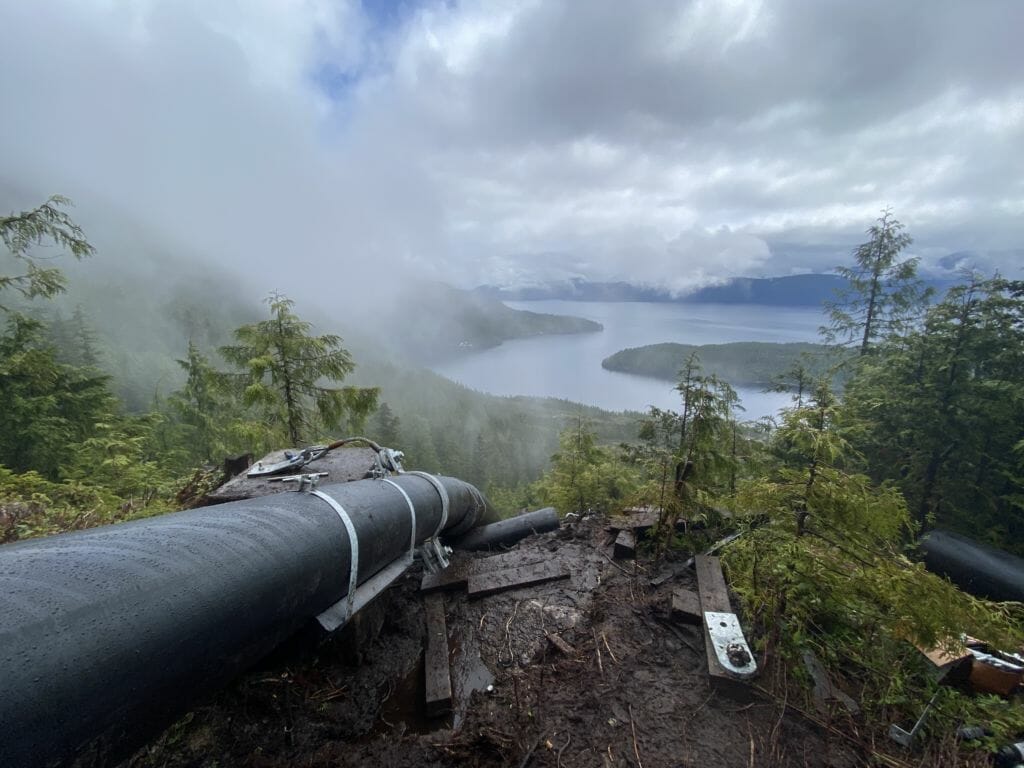
During the COVID-19 pandemic, Kitasoo Xai’xais shut down Klemtu to visitors, making it difficult to bring in outside workers.
“It was extremely challenging to build at that time,” says Chief Neasloss. “Just trying to get crews to come in at a time when communities were closing because of COVID. There were a lot of tight deadlines and timelines.”
To maintain the project timeline and budget, the band council allowed workers to set up a camp outside the community. Workers stayed in trailers parked outside the powerhouse, eliminating the need for contact with Klemtu residents.
When it was safe to initiate some contact, the project team hired community members to monitor environmental impacts, creating temporary employment opportunities.
Powering Klemtu’s Future
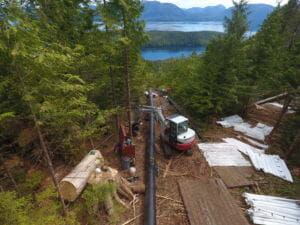
With a larger and more stable supply of electricity, Kitasoo Xai’xais can build additional housing for Klemtu residents, including a new subdivision that’s been on hold for years because of the restrictions on the amount of power the community could supply.
That’s great news for Isaiah Robinson. As general manager of the Kitasoo Development Corporation, Robinson oversees the operation of the band’s businesses – including Spirit Bear Lodge, the Kitasoo Band Store, Kitasoo Forestry, and aquaculture partnerships.
“With the hydro expansion, we now have the ability to build more homes to then provide more opportunities for [our members] to come back home,” Robinson says. “That’s the big picture.”
By expanding infrastructure, he hopes to provide more services to community members and help attract and retain professionals, like teachers and healthcare workers. Housing, energy, and food security are critical parts of that vision.
We want to be the greenest community on the BC coast. We can move to zero emissions – that’s our goal – and we’re well on our way to doing that.
“I want prosperity,” Robinson says. “Not just for us, but for all the Nations along the coast…That’s everybody having a job and being comfortable and being happy and healthy.”
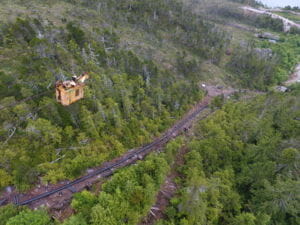
“We want to be the greenest community on the BC coast,” says Chief Neasloss. “We can move to zero emissions – that’s our goal – and we’re well on our way to doing that.”
With the upgrades to the penstock, intake, and powerhouse complete, and new solar panels on the school supplying additional electricity, the Kitasoo Xai’xais are upgrading their power distribution system and installing heat pumps.
“That’s allowing us to get off the oil furnaces that every household has right now. And then we want to do the same thing for hot water tanks,” says Chief Neasloss.
By his estimate, the Nation has installed 20 heat pumps to date, with another 50 or 60 left to install in 2022. Because the Nation owns its own power plant, it’s able to charge a low, fixed rate for electricity. By supporting community members to switch from fossil fuel-powered furnaces to electric heat pumps, Kitasoo Xai’xais saves Klemtu residents about $3,000 a year in heating costs.
“Those are all initiatives that work into this green economy that we’re hoping to have,” says Robinson. “And so, those things would not be possible if we didn’t have the power that we have now.”

As the climate changes, the community can expect more heat events and less predictable rainfall in future years. With the adjusted intake and widened penstock, the community has a more resilient hydro system and the tools to manage the supply of water and energy.
To get ahead of future climate challenges, the Kitasoo Xai’xais are maintaining the diesel generator as a backup, modernizing a second powerhouse at the top of the mountain, and continuing to explore renewable energy options, including battery storage.
“The plan is to have self-sufficiency at the end,” says Robinson. “That’s a pretty big thing to take on.”
In 2020, Coast Economic Development Society approved $4.6 million, through the Renewable Energy for Remote Communities program which is part of the Province of British Columbia’s CleanBC plan, for Kitasoo Xai’xais to modernize and upgrade their hydropower facility in Klemtu.
Published On April 26, 2022 | Edited On February 17, 2023


